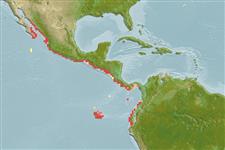Classification / Names
Common names from other countries
Main reference
Size / Weight / Age
Max length : 12.5 cm TL male/unsexed; (Ref. 96339); common length : 8.0 cm TL male/unsexed; (Ref. 55763)
Environment
Marine; pelagic-neritic; depth range 0 - 50 m (Ref. 189)
Climate / Range
Tropical, preferred ?; 28°N - 5°S, 111°W - 77°W (Ref. 189)
Distribution
Short description
Dorsal
spines
(total): 0;
Anal
spines: 0;
Anal
soft rays: 14 - 17. Body fairly elongate. Snout long, about equal to eye diameter; maxilla moderate, tip rather bluntly pointed, reaching onto inter-operculum, but not to edge of gill cover; gill cover canals of panamensis-type. Anal fin very short, its origin below or behind last dorsal fin ray base. A silver stripe along flank, about 3/4 eye diameter.
IUCN Red List Status (Ref. 115185)
Threat to humans
Harmless
Human uses
Fisheries: subsistence fisheries
More information
Age/SizeGrowthLength-weightLength-lengthLength-frequenciesMorphometricsMorphologyLarvaeLarval dynamicsRecruitmentAbundance
ReferencesAquacultureAquaculture profileStrainsGeneticsAllele frequenciesHeritabilityDiseasesProcessingMass conversion
Tools
Special reports
Download XML
Internet sources
Estimates of some properties based on models
Phylogenetic diversity index
PD50 = 0.5000 many relatives (e.g. carps) 0.5 - 2.0 few relatives (e.g. lungfishes)
Trophic Level
3.4 ±0.4 se; Based on size and trophs of closest relatives
Resilience
High, minimum population doubling time less than 15 months (Preliminary K or Fecundity.)
Vulnerability
Low vulnerability (14 of 100)
Price category
